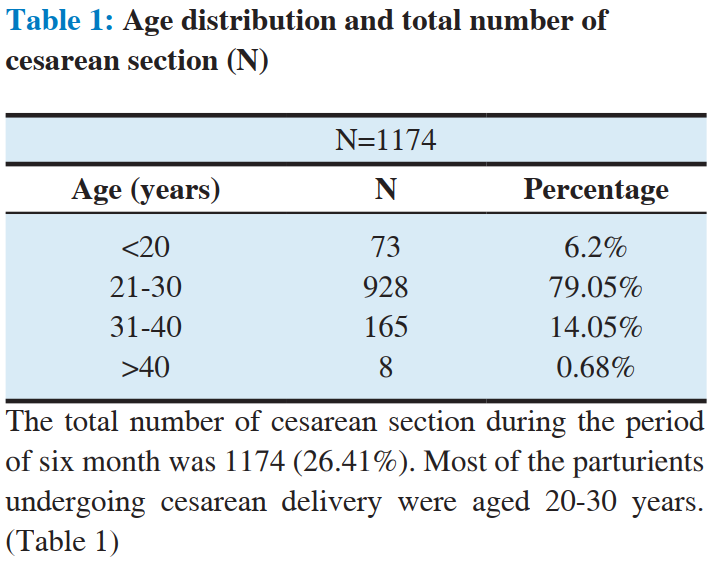Abstract
Background:
Regional anesthesia is being utilized as the preferred anesthetic
technique for cesarean delivery worldwide. This study was performed to
review cesarean delivery anesthetic practice in our institute which represents
a tertiary care regional hospital.
Methods:
Data was collected regarding the
number of cesarean delivery performed during the period of six months from
January 2017 to June 2017 at Western Regional Hospital. Number of elective
versus emergency cesarean delivery, mode of anesthesia and the reason for
general anesthesia and complications was recorded.
Results:
The number of
cesarean delivery was found to be 1174(26.41%) of total deliveries during
the study period. Out of which, 64.82% were for emergency indication and
35.18% were elective cesarean delivery. Spinal anesthesia was utilized in
99.03% of elective cesarean section and 97.63% of emergency cesarean
section. The percentage of cases performed under general anesthesia was
1.87%. Reasons for general anesthesia included inadequate subarachnoid
block, fetal malpresentation, eclampsia and maternal comorbidities.
Complications related to general anesthesia like failed intubation, airway
difficulty related to general anesthesia and anesthesia related mortality was
not encountered.
Conclusion:
Spinal anesthesia is utilized widely and safely
in obstetric practice at our hospital. Use of labour epidural analgesia should
be introduced and encouraged in our setting to minimize the side effects of
single shot spinal anesthesia and to avoid general anesthesia when indicated.
References
Matters. 2015 May;23(45):149–50. Rollins M, Lucero J.
Overview of anesthetic considerations for Cesarean delivery. Br
Med Bull. 2012;101:105–25.
2. Practice guidelines for obstetric anesthesia: an updated report
by the American Society of Anesthesiologists Task Force on
Obstetric Anesthesia. Anesthesiology. 2007 Apr;106(4):843–63.
3. Government of Nepal, Ministry of Health, Pokhara Academy of
Health Sciences WRH. Annual Report 2072/2073. 2017:1–33.
4. Kinsella SM, Walton B, Sashidharan R, Draycott T. Category-1
caesarean section: a survey of anaesthetic and peri-operative
management in the UK. Anaesthesia. 2010 Apr;65(4):362–8.
5. Palanisamy A, Mitani AA, Tsen LC. General anesthesia for
cesarean delivery at a tertiary care hospital from 2000 to 2005:
a retrospective analysis and 10-year update. Int J Obstet Anesth.
2011 Jan;20(1):10–6.
6. Classification of urgency of caesarean section- A Classification of
Urgency of Caesarean Section- A Continum of Risk. Good Pract
No 11. 2010:1-4
7. Aiono-Le Tagaloa L, Butwick AJ, Carvalho B. A survey of
perioperative and postoperative anesthetic practices for cesarean
delivery. Anesthesiol Res Pract. 2009;2009:510642.
8. Kinsella SM, Girgirah K, Scrutton MJL. Rapid sequence spinal
anaesthesia for category-1 urgency caesarean section: a case
series. Anaesthesia. 2010 Jul;65(7):664–9.
9. Stamer UM, Wiese R, Stuber F, Wulf H, Meuser T. Change in
anaesthetic practice for Caesarean section in Germany. Acta
Anaesthesiol Scand. 2005 Feb;49(2):170–6.
10. Sumikura H. Anesthetic management of urgent cesarean section.
Hypertens Res Pregnancy. 2016;4(1):1–5.
11. Leighton BL, Halpern SH. The effects of epidural analgesia on
labor, maternal, and neonatal outcomes: a systematic review. Am
J Obstet Gynecol. 2002 May;186(5 Suppl Nature):S69-77.
12. Anim-Somuah M, Smyth R, Howell C. Epidural versus nonepidural or no analgesia in labour. Cochrane database Syst Rev.
2005 Oct;(4):CD000331.
13. Halpern SH, Muir H, Breen TW, Campbell DC, Barrett J, Liston
R, et al. A multicenter randomized controlled trial comparing
patient-controlled epidural with intravenous analgesia for pain
relief in labor. Anesth Analg. 2004 Nov;99(5):1532–8.
14. Ohel G, Gonen R, Vaida S, Barak S, Gaitini L. Early versus late
initiation of epidural analgesia in labor: does it increase the risk
of cesarean section? A randomized trial. Am J Obstet Gynecol.
2006 Mar;194(3):600–5.

